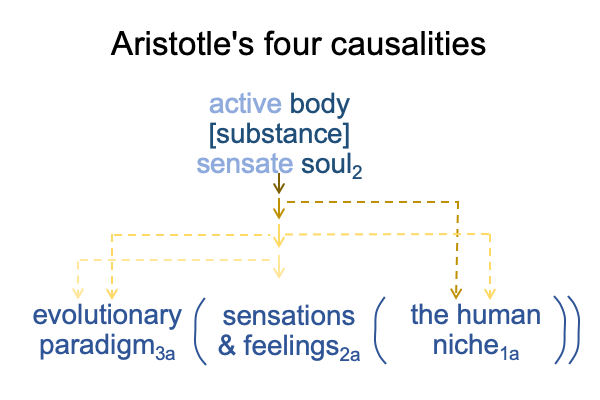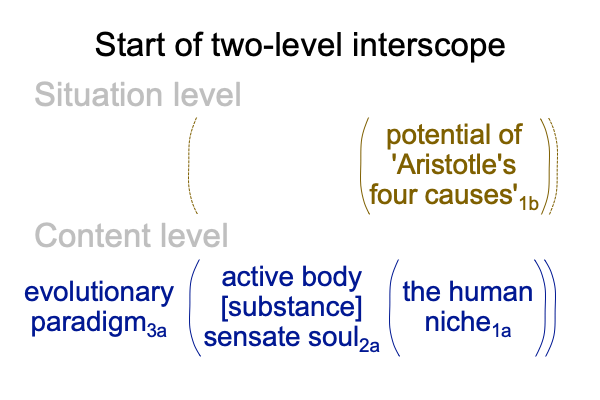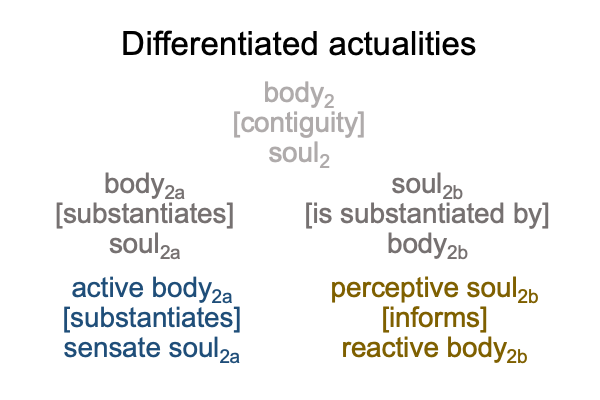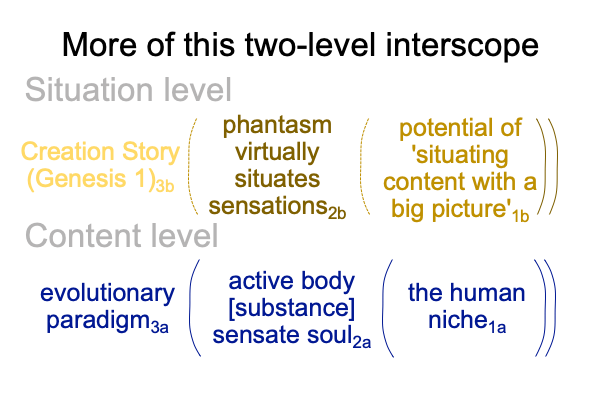0032 Where do instrumental and material causes take me?
They take me to triadic relations. The triadic relation, in the category of thirdness, brings actuality, the category of secondness, into relation with possibility, the category of firstness. Signs are triadic relations.
According to the masterwork, The Human Niche, our genus adapts to the potential of triadic relations. If I look back at the first nested form, Aristotle’s instrumental, material, final and formal causes allow me to pass from secondary to primary causes (that is, from actuality to understanding). Understanding comes at the moment that I comprehend an entire triadic relation. So, I have the possibility of being an image of God1 and I have the capacity to recognize triadic relations. One potential appears in the first chapter of Genesis. The other potential corresponds to the human as a semiotic animal.
Material and instrumental causes demystify the content level. In the normal context of an evolutionary paradigm3a, our active bodies [substance] sensate souls2a come into relation with the potential of triadic relations1a, the human niche1a. The human niche1a is what hominins ultimately adapt to. In doing so, our ancestors increasingly image God.
Yes, the human niche1a is the potential of triadic relations.
Aristotle’s instrumental and material causes can start with the same actuality2 that serves as a first approximation for the creation of humans in Genesis and produce a content-level nested form more palatable to modern biologists (who study nature as if primary causes are not relevant).
0033 Here is a picture of what happens when I apply Aristotle’s four causes to the dyadic actuality2 of active body [substance] sensate soul with the intent (final cause) of pleasing biologists and with a formalism (formal cause) compatible with science. Remember, for scientists, the positivist intellect has a rule that says, “No metaphysics”.
This content-level nested form appears free of that superstitious nonsense.

But, aren’t Aristotle’s four causes superstitious nonsense?
Uh-oh.
The content-level potential1a shifts from the possibilities inherent in the image of God1 to the human niche1a. A niche1ais the potential of an actuality that is independent of the adapting species. For humans, that actuality is triadic relations. Triadic relations give us the potential to be images of God1. That potential is the human niche1a.
0034 In regards to the content-level actuality2a, I will, on occasion, compress our sensations and feelings2a into one word, “sensations2a“, in order to refer to the content-level actuality in future diagrams.
What does this mean for the first approximation to body [substantiates] soul?
The first approximation is active body [substantiates] sensate soul.
Well, there must be a second approximation, corresponding to a situation-level actuality.
In other words, there is a second, situation-level hylomorphe2b. The situation-level normal context3b should complement the content-level normal context3a. This type of differentiation reflects a dichotomy familiar to modern academics, “the department of arts and sciences”. The arts situate the sciences.
0035 Here, Aristotle’s four causes offer a way to clarify the content level, directly, and the situation level, indirectly.
I could say that Aristotle’s four causes hold the potential to situate the content level1b. That would be correct. But, not complete.
Aristotle’s four causes, as brilliant as they are, do not offer the only way to situate content. Indeed, my use of the four causes in refining the original nested form is anything but standard. I already mentioned that the four elements work in the same manner. They are also paths to situate content-level actualities.
Understanding requires us to figure out the normal context3 and potential1 that attends to any encountered, sensed and felt actuality2. Civilized humans have devised many ways to accomplish this task, with varying degrees of success. The process is synthetic, rather than analytical. Consequently, the actuality2b that virtually situates sensations2a can be pretty crazy, but at least it2b presents the subjective sensation2a as an object that may later become intersubjective.
So, here is how the original nested form starts to differentiate into a two-level interscope

0036 I now consider the nature of the situation-level actuality2b.
A human, like an animal, can be described as a hylomorphe, body [substantiates] soul.
Here, an old, traditional word, “substance”, gains a new technical meaning. “Substance” grounds the contiguity between any two real elements in Peirce’s category of secondness. In this use, the distinction between noun and verb dissipates. The contiguity is both noun and verb, just like the word, “glue”.
0037 As it turns out, for humans, body [substantiates] soul is not equivalent to its commutation, soul [is substantiated by] body. I already appreciate this with the content-level hylomorphe, active body [substantiates] sensate soul2a, suggesting that the situation-level actuality is the commutation.
0038 Here is a picture of the differentiation of the original hylomorphe.

0039 What is the reactive body?
It is the seat of the emotions.
Is there a name for the perceptive soul [informs] the reactive body2b?
Yes, it2b is called a “phantasm”.
Perceptive soul [informs] reactive body2b virtually (not directly) emerges from (and situates) active body [substantiates] sensate soul2a.
Phantasm2b virtually (not directly) emerges from (and situates) sensations2a.
0040 At this point, a final cause for the original nested form (of primary and secondary causation) comes into view.
The normal context of the Lebenswelt that we evolved in (revealed by Genesis One)3 brings the actuality of body [substance] soul2 into relation with the potential of the descriptor, “image of God”1.
0041 The final cause is the purpose, the goal and the end of the original nested form. Final causes entangle primary and secondary causations.
The formal cause harmonizes the normal context3 and actuality2, suggesting that the Creation Story puts the human body and mind into context.
The same final causes apply to the content-level nested form.
The normal context of scientific inquiry into evolution3a brings the actuality of the active body [substance] sensate soul2ainto relation with the human niche1a.
The final cause says that the human body and mind2a situates the potential of triadic relations (such as sign-relations)1awithin an evolutionary framework3a. The problem faced by evolutionary anthropologists is the troubling reality that triadic relations are immaterial beings.
Well, they1a are immaterial beings that entangle material and instrumental causes.
Here is the difficulty. For scientists, the formal cause, the harmonization of the evolutionary paradigm3a and the human body and mind2a, should not break the rule of the positivist intellect. Metaphysics is not allowed. Unfortunately, metaphysics is required when the human niche1a is the potential of triadic relations1a.
0042 So, the original actuality of body [substance] soul differentiates.
“Sensations2a” (active body [substance] sensate soul) is a good word for the content-level actuality.
“Phantasm2b” and “perception2b” (perceptive soul [informs] reactive body) are good words for the situation-level actuality.

0043 A two-level interscope characterizes sensible thinking.
If I look at the original nested form for the Genesis Creation Story, I can start to figure out what the situation-level normal context3b and potential1b must be. Note, the potential1b will not be Aristotle’s four causes. Rather, it will be a picture that encompasses them.
We humans think sensibly. We rarely question the formal design. Our incredible abilities to situate content are good enough. Once we start to question what is sensible, then we begin to discern another level, the perspective levelc.
